ENRP20001: Investigating Rainwater Harvesting Potentials in Australia
VerifiedAdded on 2023/06/10
|41
|11705
|87
Report
AI Summary
This report investigates the potential of rainwater harvesting systems in Melbourne and Adelaide as a solution to water scarcity. It highlights the increasing problem of water scarcity in Australia, particularly in Melbourne and Adelaide, due to population growth and climate change. The study aims to create computerized simulation models to estimate the amount of rainwater that can be harvested per unit roof area in both cities, considering factors like annual rainfall, system type, size, and efficiency. A water balance model is developed to determine the percentage of water demand that can be met through rainwater harvesting. The methodology includes using Google Earth to calculate roof surface areas, correcting digitized areas, estimating potential harvested rainwater volumes, and comparing water demand and supply gaps. The research justifies the need for alternative water sources and aims to provide policymakers with insights for promoting rainwater harvesting systems to increase water supply and reduce reliance on mains supply. Desklib provides access to this and similar solved assignments for students.
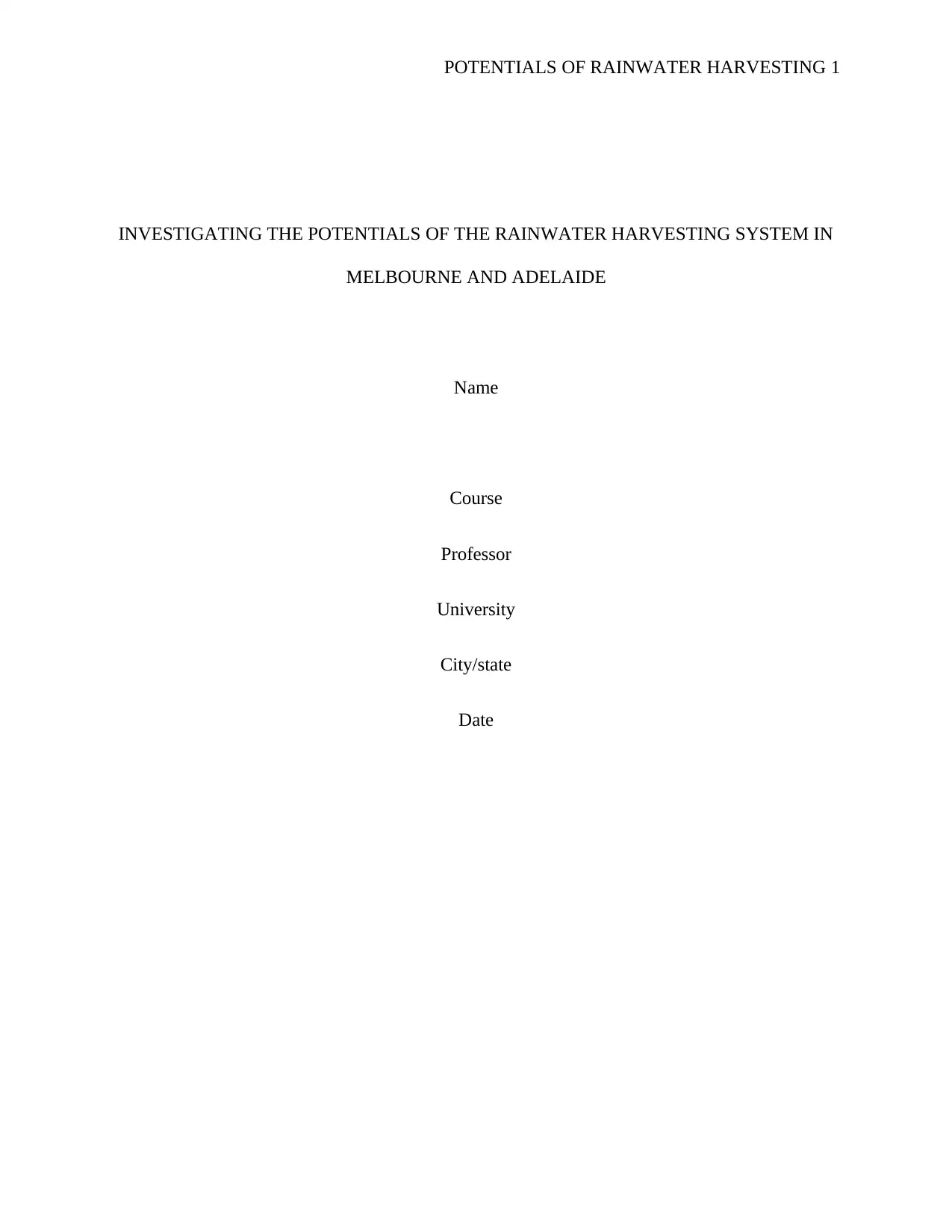
POTENTIALS OF RAINWATER HARVESTING 1
INVESTIGATING THE POTENTIALS OF THE RAINWATER HARVESTING SYSTEM IN
MELBOURNE AND ADELAIDE
Name
Course
Professor
University
City/state
Date
INVESTIGATING THE POTENTIALS OF THE RAINWATER HARVESTING SYSTEM IN
MELBOURNE AND ADELAIDE
Name
Course
Professor
University
City/state
Date
Paraphrase This Document
Need a fresh take? Get an instant paraphrase of this document with our AI Paraphraser
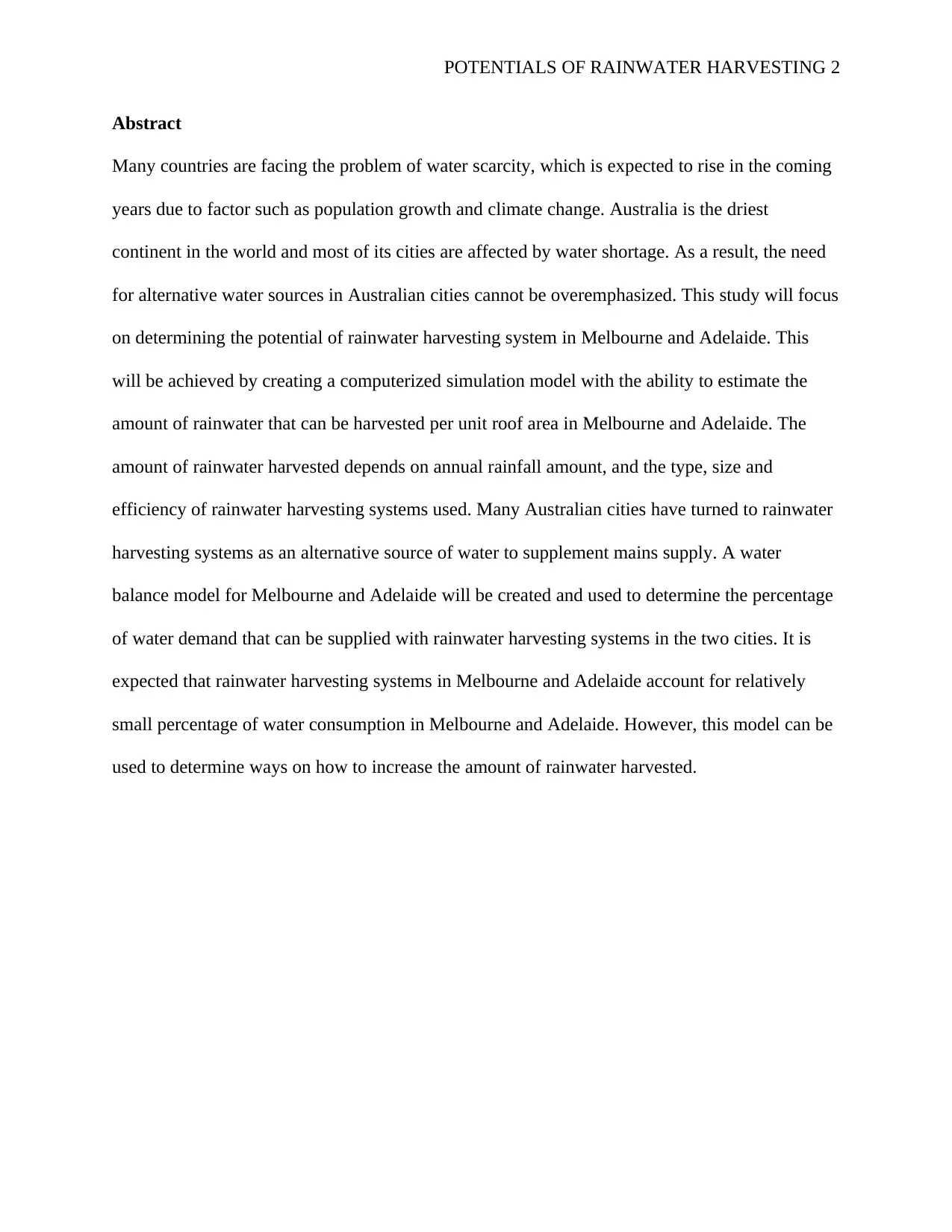
POTENTIALS OF RAINWATER HARVESTING 2
Abstract
Many countries are facing the problem of water scarcity, which is expected to rise in the coming
years due to factor such as population growth and climate change. Australia is the driest
continent in the world and most of its cities are affected by water shortage. As a result, the need
for alternative water sources in Australian cities cannot be overemphasized. This study will focus
on determining the potential of rainwater harvesting system in Melbourne and Adelaide. This
will be achieved by creating a computerized simulation model with the ability to estimate the
amount of rainwater that can be harvested per unit roof area in Melbourne and Adelaide. The
amount of rainwater harvested depends on annual rainfall amount, and the type, size and
efficiency of rainwater harvesting systems used. Many Australian cities have turned to rainwater
harvesting systems as an alternative source of water to supplement mains supply. A water
balance model for Melbourne and Adelaide will be created and used to determine the percentage
of water demand that can be supplied with rainwater harvesting systems in the two cities. It is
expected that rainwater harvesting systems in Melbourne and Adelaide account for relatively
small percentage of water consumption in Melbourne and Adelaide. However, this model can be
used to determine ways on how to increase the amount of rainwater harvested.
Abstract
Many countries are facing the problem of water scarcity, which is expected to rise in the coming
years due to factor such as population growth and climate change. Australia is the driest
continent in the world and most of its cities are affected by water shortage. As a result, the need
for alternative water sources in Australian cities cannot be overemphasized. This study will focus
on determining the potential of rainwater harvesting system in Melbourne and Adelaide. This
will be achieved by creating a computerized simulation model with the ability to estimate the
amount of rainwater that can be harvested per unit roof area in Melbourne and Adelaide. The
amount of rainwater harvested depends on annual rainfall amount, and the type, size and
efficiency of rainwater harvesting systems used. Many Australian cities have turned to rainwater
harvesting systems as an alternative source of water to supplement mains supply. A water
balance model for Melbourne and Adelaide will be created and used to determine the percentage
of water demand that can be supplied with rainwater harvesting systems in the two cities. It is
expected that rainwater harvesting systems in Melbourne and Adelaide account for relatively
small percentage of water consumption in Melbourne and Adelaide. However, this model can be
used to determine ways on how to increase the amount of rainwater harvested.
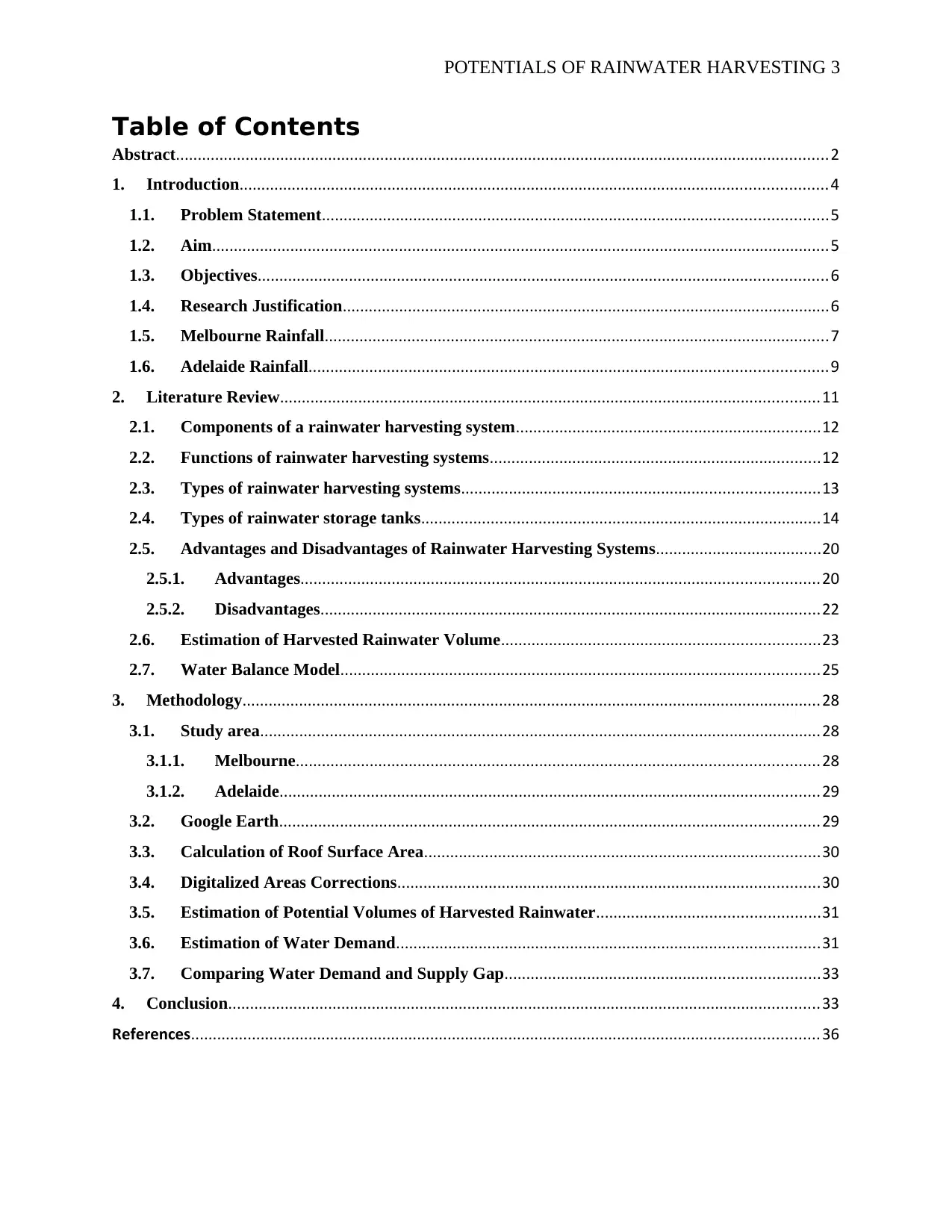
POTENTIALS OF RAINWATER HARVESTING 3
Table of Contents
Abstract......................................................................................................................................................2
1. Introduction.......................................................................................................................................4
1.1. Problem Statement....................................................................................................................5
1.2. Aim..............................................................................................................................................5
1.3. Objectives...................................................................................................................................6
1.4. Research Justification................................................................................................................6
1.5. Melbourne Rainfall....................................................................................................................7
1.6. Adelaide Rainfall.......................................................................................................................9
2. Literature Review............................................................................................................................11
2.1. Components of a rainwater harvesting system......................................................................12
2.2. Functions of rainwater harvesting systems............................................................................12
2.3. Types of rainwater harvesting systems..................................................................................13
2.4. Types of rainwater storage tanks............................................................................................14
2.5. Advantages and Disadvantages of Rainwater Harvesting Systems......................................20
2.5.1. Advantages.......................................................................................................................20
2.5.2. Disadvantages...................................................................................................................22
2.6. Estimation of Harvested Rainwater Volume.........................................................................23
2.7. Water Balance Model..............................................................................................................25
3. Methodology.....................................................................................................................................28
3.1. Study area.................................................................................................................................28
3.1.1. Melbourne........................................................................................................................28
3.1.2. Adelaide............................................................................................................................29
3.2. Google Earth............................................................................................................................29
3.3. Calculation of Roof Surface Area...........................................................................................30
3.4. Digitalized Areas Corrections.................................................................................................30
3.5. Estimation of Potential Volumes of Harvested Rainwater...................................................31
3.6. Estimation of Water Demand.................................................................................................31
3.7. Comparing Water Demand and Supply Gap........................................................................33
4. Conclusion........................................................................................................................................33
References................................................................................................................................................36
Table of Contents
Abstract......................................................................................................................................................2
1. Introduction.......................................................................................................................................4
1.1. Problem Statement....................................................................................................................5
1.2. Aim..............................................................................................................................................5
1.3. Objectives...................................................................................................................................6
1.4. Research Justification................................................................................................................6
1.5. Melbourne Rainfall....................................................................................................................7
1.6. Adelaide Rainfall.......................................................................................................................9
2. Literature Review............................................................................................................................11
2.1. Components of a rainwater harvesting system......................................................................12
2.2. Functions of rainwater harvesting systems............................................................................12
2.3. Types of rainwater harvesting systems..................................................................................13
2.4. Types of rainwater storage tanks............................................................................................14
2.5. Advantages and Disadvantages of Rainwater Harvesting Systems......................................20
2.5.1. Advantages.......................................................................................................................20
2.5.2. Disadvantages...................................................................................................................22
2.6. Estimation of Harvested Rainwater Volume.........................................................................23
2.7. Water Balance Model..............................................................................................................25
3. Methodology.....................................................................................................................................28
3.1. Study area.................................................................................................................................28
3.1.1. Melbourne........................................................................................................................28
3.1.2. Adelaide............................................................................................................................29
3.2. Google Earth............................................................................................................................29
3.3. Calculation of Roof Surface Area...........................................................................................30
3.4. Digitalized Areas Corrections.................................................................................................30
3.5. Estimation of Potential Volumes of Harvested Rainwater...................................................31
3.6. Estimation of Water Demand.................................................................................................31
3.7. Comparing Water Demand and Supply Gap........................................................................33
4. Conclusion........................................................................................................................................33
References................................................................................................................................................36
⊘ This is a preview!⊘
Do you want full access?
Subscribe today to unlock all pages.

Trusted by 1+ million students worldwide
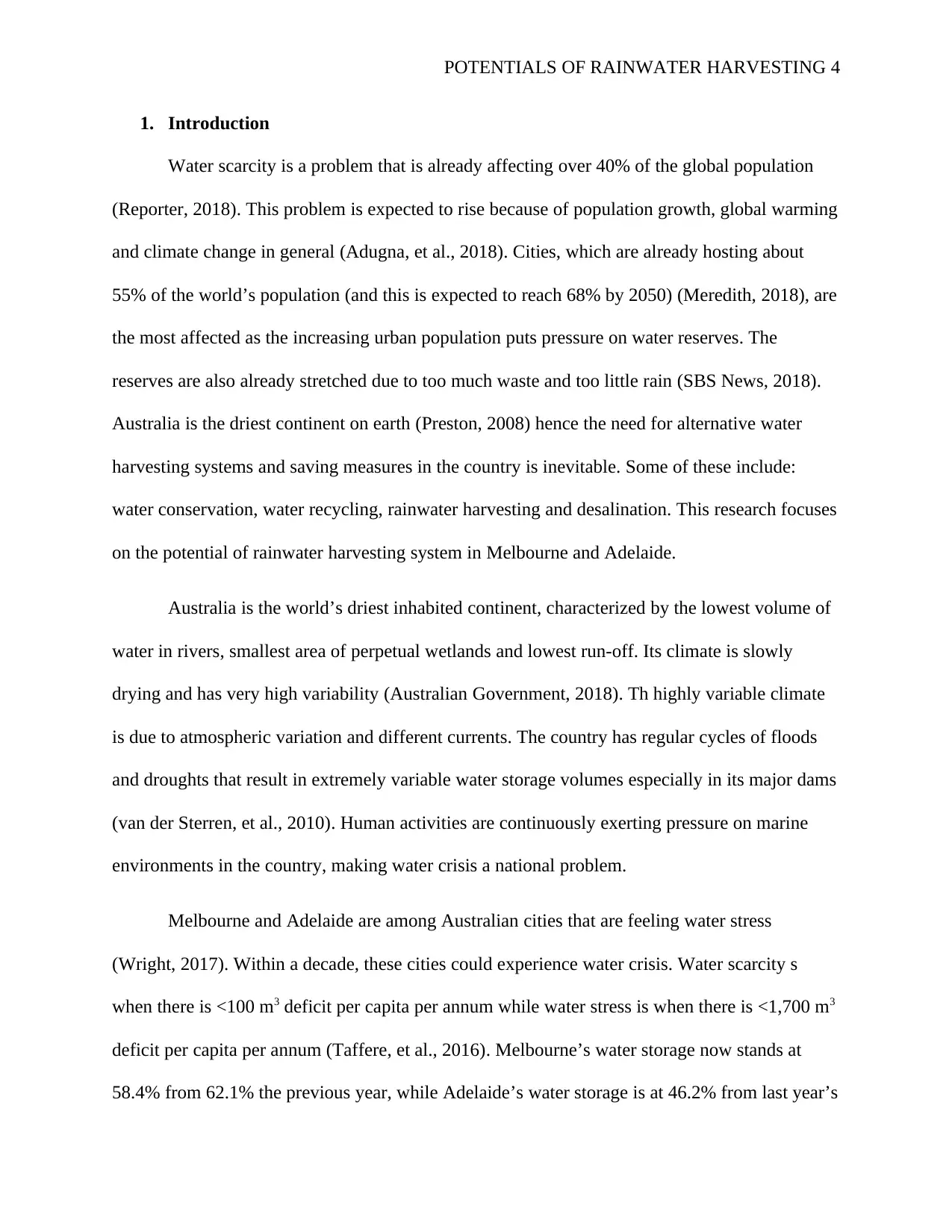
POTENTIALS OF RAINWATER HARVESTING 4
1. Introduction
Water scarcity is a problem that is already affecting over 40% of the global population
(Reporter, 2018). This problem is expected to rise because of population growth, global warming
and climate change in general (Adugna, et al., 2018). Cities, which are already hosting about
55% of the world’s population (and this is expected to reach 68% by 2050) (Meredith, 2018), are
the most affected as the increasing urban population puts pressure on water reserves. The
reserves are also already stretched due to too much waste and too little rain (SBS News, 2018).
Australia is the driest continent on earth (Preston, 2008) hence the need for alternative water
harvesting systems and saving measures in the country is inevitable. Some of these include:
water conservation, water recycling, rainwater harvesting and desalination. This research focuses
on the potential of rainwater harvesting system in Melbourne and Adelaide.
Australia is the world’s driest inhabited continent, characterized by the lowest volume of
water in rivers, smallest area of perpetual wetlands and lowest run-off. Its climate is slowly
drying and has very high variability (Australian Government, 2018). Th highly variable climate
is due to atmospheric variation and different currents. The country has regular cycles of floods
and droughts that result in extremely variable water storage volumes especially in its major dams
(van der Sterren, et al., 2010). Human activities are continuously exerting pressure on marine
environments in the country, making water crisis a national problem.
Melbourne and Adelaide are among Australian cities that are feeling water stress
(Wright, 2017). Within a decade, these cities could experience water crisis. Water scarcity s
when there is <100 m3 deficit per capita per annum while water stress is when there is <1,700 m3
deficit per capita per annum (Taffere, et al., 2016). Melbourne’s water storage now stands at
58.4% from 62.1% the previous year, while Adelaide’s water storage is at 46.2% from last year’s
1. Introduction
Water scarcity is a problem that is already affecting over 40% of the global population
(Reporter, 2018). This problem is expected to rise because of population growth, global warming
and climate change in general (Adugna, et al., 2018). Cities, which are already hosting about
55% of the world’s population (and this is expected to reach 68% by 2050) (Meredith, 2018), are
the most affected as the increasing urban population puts pressure on water reserves. The
reserves are also already stretched due to too much waste and too little rain (SBS News, 2018).
Australia is the driest continent on earth (Preston, 2008) hence the need for alternative water
harvesting systems and saving measures in the country is inevitable. Some of these include:
water conservation, water recycling, rainwater harvesting and desalination. This research focuses
on the potential of rainwater harvesting system in Melbourne and Adelaide.
Australia is the world’s driest inhabited continent, characterized by the lowest volume of
water in rivers, smallest area of perpetual wetlands and lowest run-off. Its climate is slowly
drying and has very high variability (Australian Government, 2018). Th highly variable climate
is due to atmospheric variation and different currents. The country has regular cycles of floods
and droughts that result in extremely variable water storage volumes especially in its major dams
(van der Sterren, et al., 2010). Human activities are continuously exerting pressure on marine
environments in the country, making water crisis a national problem.
Melbourne and Adelaide are among Australian cities that are feeling water stress
(Wright, 2017). Within a decade, these cities could experience water crisis. Water scarcity s
when there is <100 m3 deficit per capita per annum while water stress is when there is <1,700 m3
deficit per capita per annum (Taffere, et al., 2016). Melbourne’s water storage now stands at
58.4% from 62.1% the previous year, while Adelaide’s water storage is at 46.2% from last year’s
Paraphrase This Document
Need a fresh take? Get an instant paraphrase of this document with our AI Paraphraser
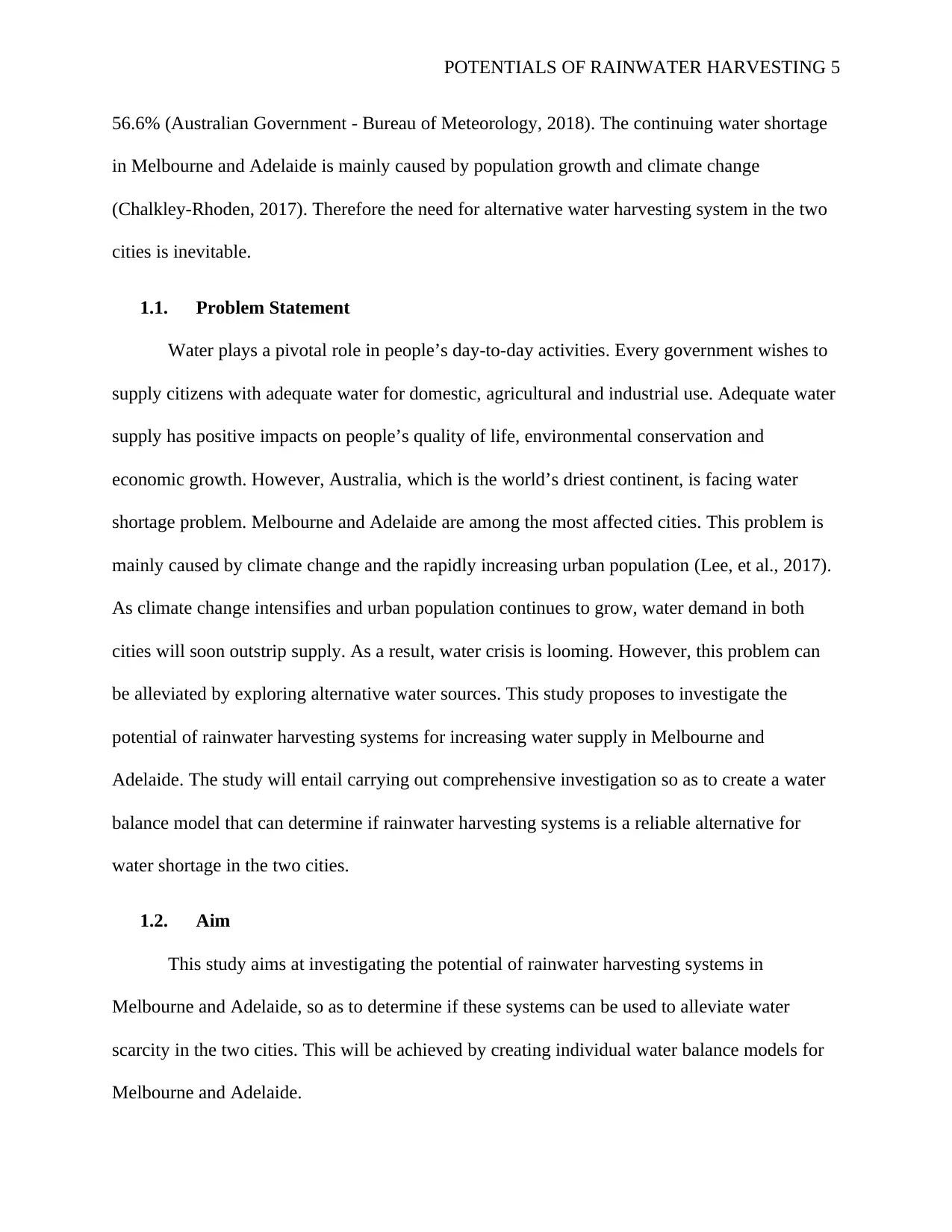
POTENTIALS OF RAINWATER HARVESTING 5
56.6% (Australian Government - Bureau of Meteorology, 2018). The continuing water shortage
in Melbourne and Adelaide is mainly caused by population growth and climate change
(Chalkley-Rhoden, 2017). Therefore the need for alternative water harvesting system in the two
cities is inevitable.
1.1. Problem Statement
Water plays a pivotal role in people’s day-to-day activities. Every government wishes to
supply citizens with adequate water for domestic, agricultural and industrial use. Adequate water
supply has positive impacts on people’s quality of life, environmental conservation and
economic growth. However, Australia, which is the world’s driest continent, is facing water
shortage problem. Melbourne and Adelaide are among the most affected cities. This problem is
mainly caused by climate change and the rapidly increasing urban population (Lee, et al., 2017).
As climate change intensifies and urban population continues to grow, water demand in both
cities will soon outstrip supply. As a result, water crisis is looming. However, this problem can
be alleviated by exploring alternative water sources. This study proposes to investigate the
potential of rainwater harvesting systems for increasing water supply in Melbourne and
Adelaide. The study will entail carrying out comprehensive investigation so as to create a water
balance model that can determine if rainwater harvesting systems is a reliable alternative for
water shortage in the two cities.
1.2. Aim
This study aims at investigating the potential of rainwater harvesting systems in
Melbourne and Adelaide, so as to determine if these systems can be used to alleviate water
scarcity in the two cities. This will be achieved by creating individual water balance models for
Melbourne and Adelaide.
56.6% (Australian Government - Bureau of Meteorology, 2018). The continuing water shortage
in Melbourne and Adelaide is mainly caused by population growth and climate change
(Chalkley-Rhoden, 2017). Therefore the need for alternative water harvesting system in the two
cities is inevitable.
1.1. Problem Statement
Water plays a pivotal role in people’s day-to-day activities. Every government wishes to
supply citizens with adequate water for domestic, agricultural and industrial use. Adequate water
supply has positive impacts on people’s quality of life, environmental conservation and
economic growth. However, Australia, which is the world’s driest continent, is facing water
shortage problem. Melbourne and Adelaide are among the most affected cities. This problem is
mainly caused by climate change and the rapidly increasing urban population (Lee, et al., 2017).
As climate change intensifies and urban population continues to grow, water demand in both
cities will soon outstrip supply. As a result, water crisis is looming. However, this problem can
be alleviated by exploring alternative water sources. This study proposes to investigate the
potential of rainwater harvesting systems for increasing water supply in Melbourne and
Adelaide. The study will entail carrying out comprehensive investigation so as to create a water
balance model that can determine if rainwater harvesting systems is a reliable alternative for
water shortage in the two cities.
1.2. Aim
This study aims at investigating the potential of rainwater harvesting systems in
Melbourne and Adelaide, so as to determine if these systems can be used to alleviate water
scarcity in the two cities. This will be achieved by creating individual water balance models for
Melbourne and Adelaide.
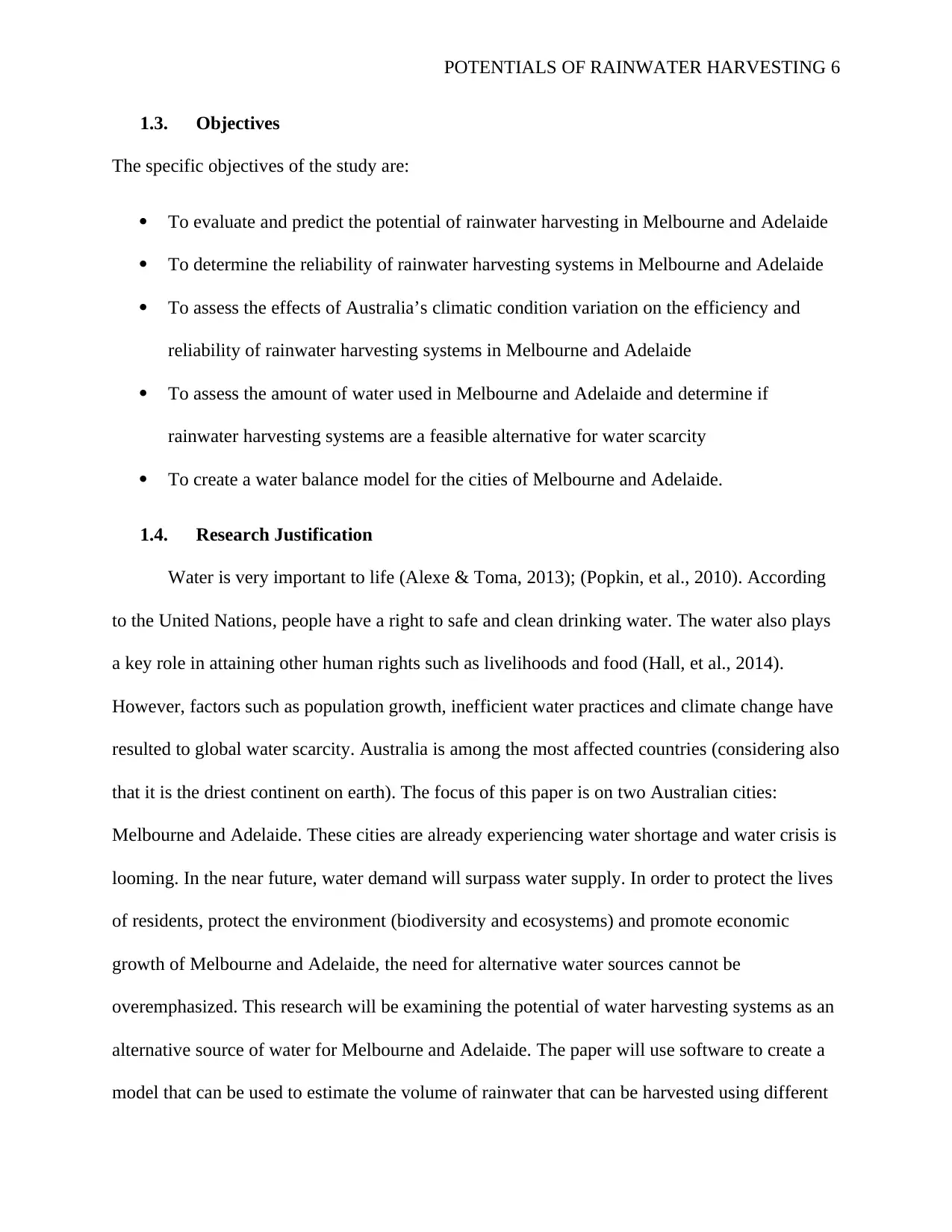
POTENTIALS OF RAINWATER HARVESTING 6
1.3. Objectives
The specific objectives of the study are:
To evaluate and predict the potential of rainwater harvesting in Melbourne and Adelaide
To determine the reliability of rainwater harvesting systems in Melbourne and Adelaide
To assess the effects of Australia’s climatic condition variation on the efficiency and
reliability of rainwater harvesting systems in Melbourne and Adelaide
To assess the amount of water used in Melbourne and Adelaide and determine if
rainwater harvesting systems are a feasible alternative for water scarcity
To create a water balance model for the cities of Melbourne and Adelaide.
1.4. Research Justification
Water is very important to life (Alexe & Toma, 2013); (Popkin, et al., 2010). According
to the United Nations, people have a right to safe and clean drinking water. The water also plays
a key role in attaining other human rights such as livelihoods and food (Hall, et al., 2014).
However, factors such as population growth, inefficient water practices and climate change have
resulted to global water scarcity. Australia is among the most affected countries (considering also
that it is the driest continent on earth). The focus of this paper is on two Australian cities:
Melbourne and Adelaide. These cities are already experiencing water shortage and water crisis is
looming. In the near future, water demand will surpass water supply. In order to protect the lives
of residents, protect the environment (biodiversity and ecosystems) and promote economic
growth of Melbourne and Adelaide, the need for alternative water sources cannot be
overemphasized. This research will be examining the potential of water harvesting systems as an
alternative source of water for Melbourne and Adelaide. The paper will use software to create a
model that can be used to estimate the volume of rainwater that can be harvested using different
1.3. Objectives
The specific objectives of the study are:
To evaluate and predict the potential of rainwater harvesting in Melbourne and Adelaide
To determine the reliability of rainwater harvesting systems in Melbourne and Adelaide
To assess the effects of Australia’s climatic condition variation on the efficiency and
reliability of rainwater harvesting systems in Melbourne and Adelaide
To assess the amount of water used in Melbourne and Adelaide and determine if
rainwater harvesting systems are a feasible alternative for water scarcity
To create a water balance model for the cities of Melbourne and Adelaide.
1.4. Research Justification
Water is very important to life (Alexe & Toma, 2013); (Popkin, et al., 2010). According
to the United Nations, people have a right to safe and clean drinking water. The water also plays
a key role in attaining other human rights such as livelihoods and food (Hall, et al., 2014).
However, factors such as population growth, inefficient water practices and climate change have
resulted to global water scarcity. Australia is among the most affected countries (considering also
that it is the driest continent on earth). The focus of this paper is on two Australian cities:
Melbourne and Adelaide. These cities are already experiencing water shortage and water crisis is
looming. In the near future, water demand will surpass water supply. In order to protect the lives
of residents, protect the environment (biodiversity and ecosystems) and promote economic
growth of Melbourne and Adelaide, the need for alternative water sources cannot be
overemphasized. This research will be examining the potential of water harvesting systems as an
alternative source of water for Melbourne and Adelaide. The paper will use software to create a
model that can be used to estimate the volume of rainwater that can be harvested using different
⊘ This is a preview!⊘
Do you want full access?
Subscribe today to unlock all pages.

Trusted by 1+ million students worldwide
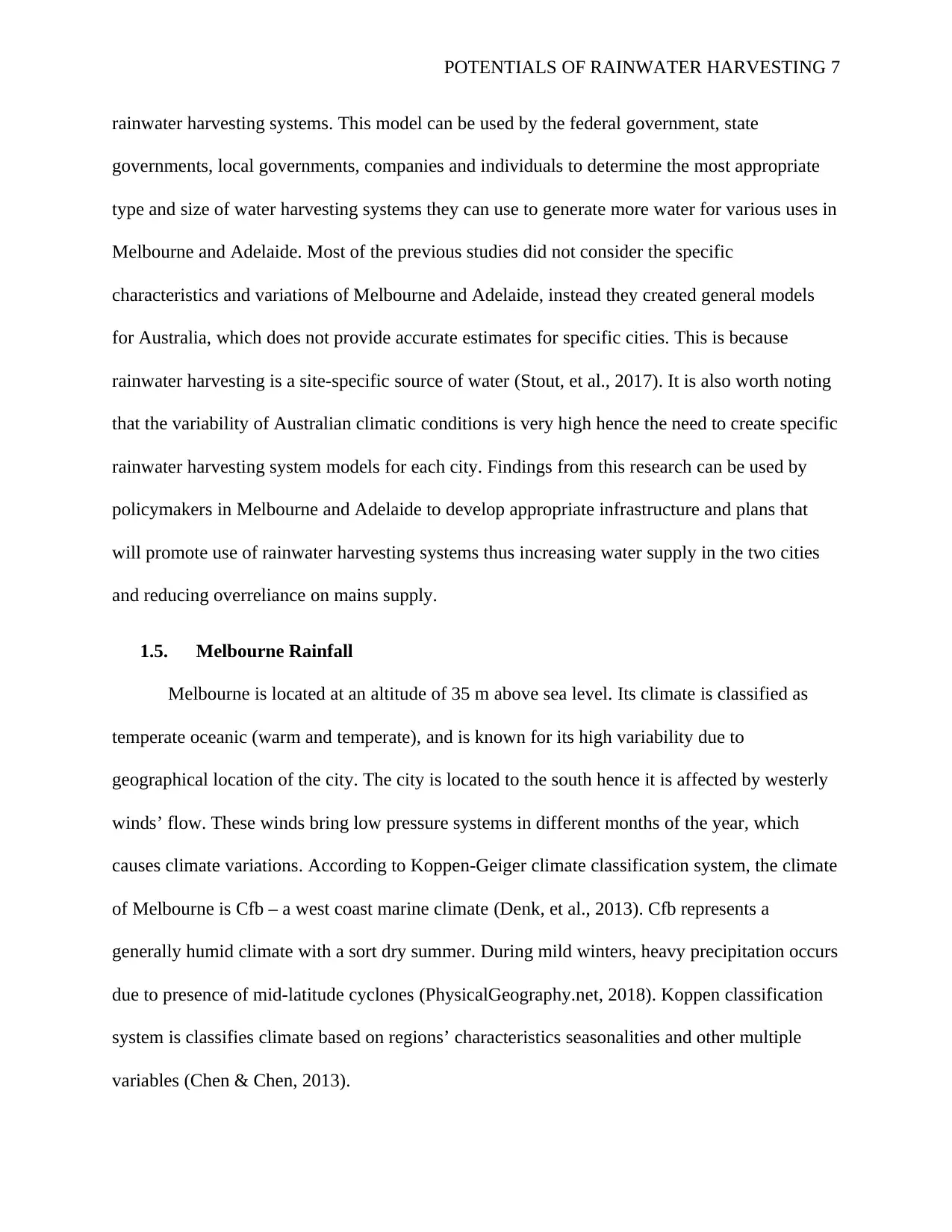
POTENTIALS OF RAINWATER HARVESTING 7
rainwater harvesting systems. This model can be used by the federal government, state
governments, local governments, companies and individuals to determine the most appropriate
type and size of water harvesting systems they can use to generate more water for various uses in
Melbourne and Adelaide. Most of the previous studies did not consider the specific
characteristics and variations of Melbourne and Adelaide, instead they created general models
for Australia, which does not provide accurate estimates for specific cities. This is because
rainwater harvesting is a site-specific source of water (Stout, et al., 2017). It is also worth noting
that the variability of Australian climatic conditions is very high hence the need to create specific
rainwater harvesting system models for each city. Findings from this research can be used by
policymakers in Melbourne and Adelaide to develop appropriate infrastructure and plans that
will promote use of rainwater harvesting systems thus increasing water supply in the two cities
and reducing overreliance on mains supply.
1.5. Melbourne Rainfall
Melbourne is located at an altitude of 35 m above sea level. Its climate is classified as
temperate oceanic (warm and temperate), and is known for its high variability due to
geographical location of the city. The city is located to the south hence it is affected by westerly
winds’ flow. These winds bring low pressure systems in different months of the year, which
causes climate variations. According to Koppen-Geiger climate classification system, the climate
of Melbourne is Cfb – a west coast marine climate (Denk, et al., 2013). Cfb represents a
generally humid climate with a sort dry summer. During mild winters, heavy precipitation occurs
due to presence of mid-latitude cyclones (PhysicalGeography.net, 2018). Koppen classification
system is classifies climate based on regions’ characteristics seasonalities and other multiple
variables (Chen & Chen, 2013).
rainwater harvesting systems. This model can be used by the federal government, state
governments, local governments, companies and individuals to determine the most appropriate
type and size of water harvesting systems they can use to generate more water for various uses in
Melbourne and Adelaide. Most of the previous studies did not consider the specific
characteristics and variations of Melbourne and Adelaide, instead they created general models
for Australia, which does not provide accurate estimates for specific cities. This is because
rainwater harvesting is a site-specific source of water (Stout, et al., 2017). It is also worth noting
that the variability of Australian climatic conditions is very high hence the need to create specific
rainwater harvesting system models for each city. Findings from this research can be used by
policymakers in Melbourne and Adelaide to develop appropriate infrastructure and plans that
will promote use of rainwater harvesting systems thus increasing water supply in the two cities
and reducing overreliance on mains supply.
1.5. Melbourne Rainfall
Melbourne is located at an altitude of 35 m above sea level. Its climate is classified as
temperate oceanic (warm and temperate), and is known for its high variability due to
geographical location of the city. The city is located to the south hence it is affected by westerly
winds’ flow. These winds bring low pressure systems in different months of the year, which
causes climate variations. According to Koppen-Geiger climate classification system, the climate
of Melbourne is Cfb – a west coast marine climate (Denk, et al., 2013). Cfb represents a
generally humid climate with a sort dry summer. During mild winters, heavy precipitation occurs
due to presence of mid-latitude cyclones (PhysicalGeography.net, 2018). Koppen classification
system is classifies climate based on regions’ characteristics seasonalities and other multiple
variables (Chen & Chen, 2013).
Paraphrase This Document
Need a fresh take? Get an instant paraphrase of this document with our AI Paraphraser
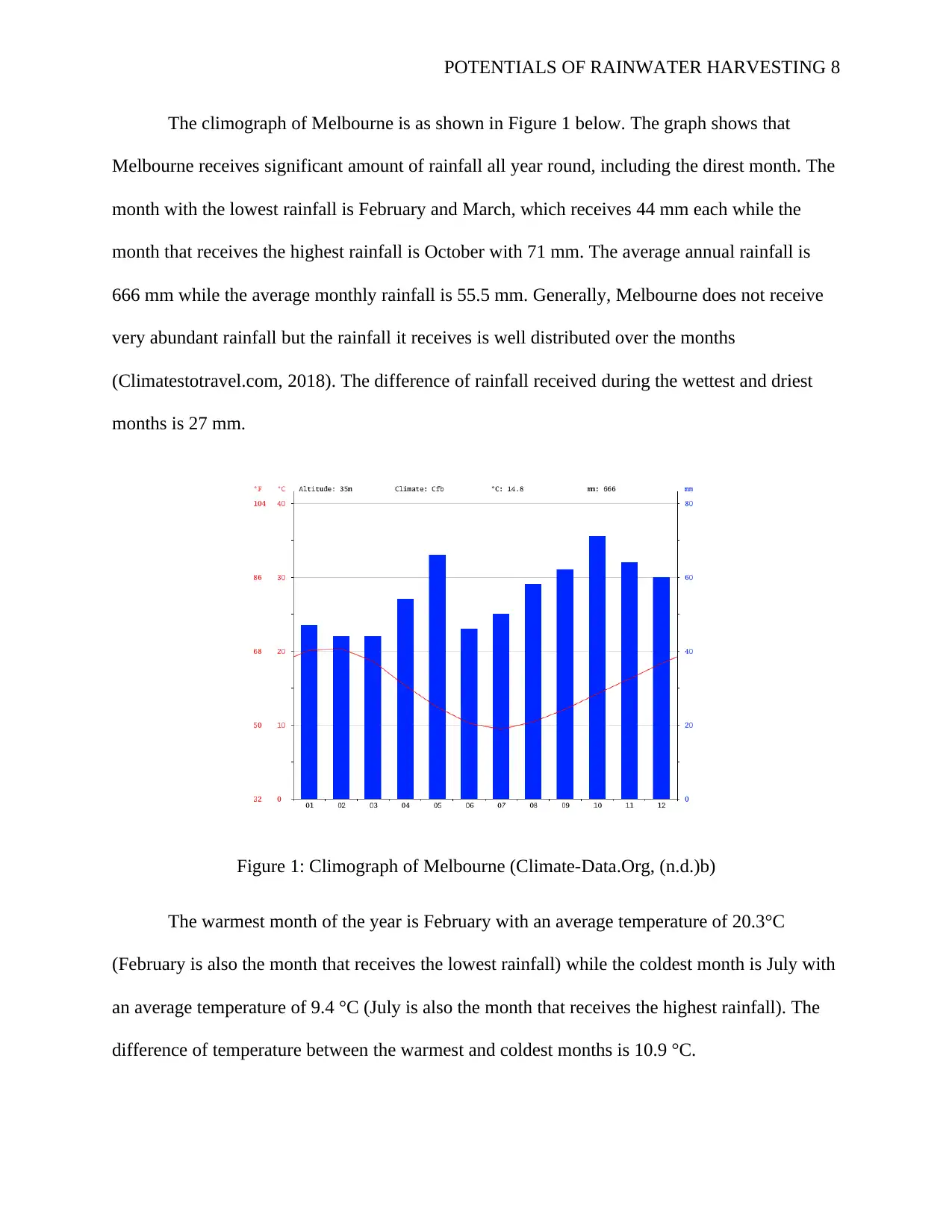
POTENTIALS OF RAINWATER HARVESTING 8
The climograph of Melbourne is as shown in Figure 1 below. The graph shows that
Melbourne receives significant amount of rainfall all year round, including the direst month. The
month with the lowest rainfall is February and March, which receives 44 mm each while the
month that receives the highest rainfall is October with 71 mm. The average annual rainfall is
666 mm while the average monthly rainfall is 55.5 mm. Generally, Melbourne does not receive
very abundant rainfall but the rainfall it receives is well distributed over the months
(Climatestotravel.com, 2018). The difference of rainfall received during the wettest and driest
months is 27 mm.
Figure 1: Climograph of Melbourne (Climate-Data.Org, (n.d.)b)
The warmest month of the year is February with an average temperature of 20.3°C
(February is also the month that receives the lowest rainfall) while the coldest month is July with
an average temperature of 9.4 °C (July is also the month that receives the highest rainfall). The
difference of temperature between the warmest and coldest months is 10.9 °C.
The climograph of Melbourne is as shown in Figure 1 below. The graph shows that
Melbourne receives significant amount of rainfall all year round, including the direst month. The
month with the lowest rainfall is February and March, which receives 44 mm each while the
month that receives the highest rainfall is October with 71 mm. The average annual rainfall is
666 mm while the average monthly rainfall is 55.5 mm. Generally, Melbourne does not receive
very abundant rainfall but the rainfall it receives is well distributed over the months
(Climatestotravel.com, 2018). The difference of rainfall received during the wettest and driest
months is 27 mm.
Figure 1: Climograph of Melbourne (Climate-Data.Org, (n.d.)b)
The warmest month of the year is February with an average temperature of 20.3°C
(February is also the month that receives the lowest rainfall) while the coldest month is July with
an average temperature of 9.4 °C (July is also the month that receives the highest rainfall). The
difference of temperature between the warmest and coldest months is 10.9 °C.
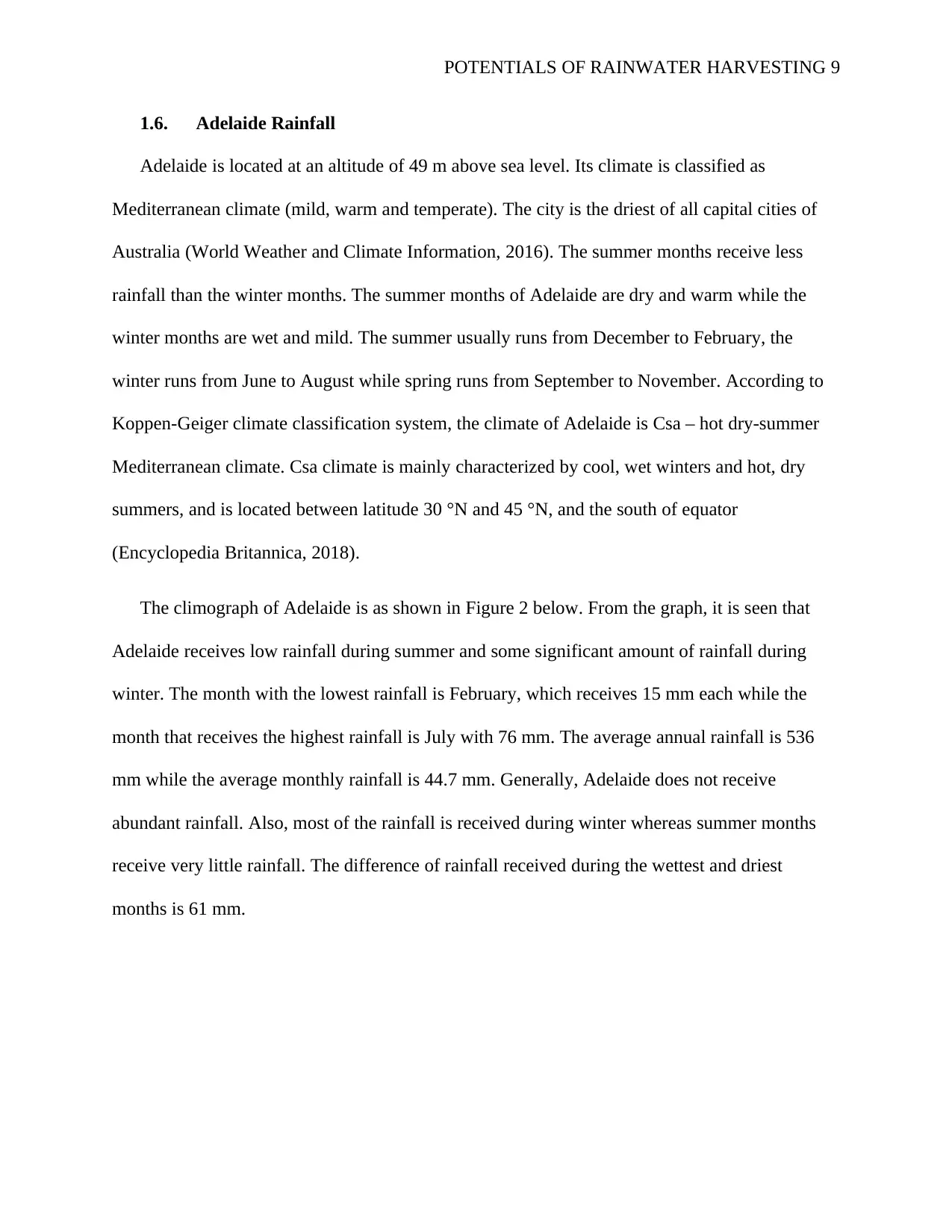
POTENTIALS OF RAINWATER HARVESTING 9
1.6. Adelaide Rainfall
Adelaide is located at an altitude of 49 m above sea level. Its climate is classified as
Mediterranean climate (mild, warm and temperate). The city is the driest of all capital cities of
Australia (World Weather and Climate Information, 2016). The summer months receive less
rainfall than the winter months. The summer months of Adelaide are dry and warm while the
winter months are wet and mild. The summer usually runs from December to February, the
winter runs from June to August while spring runs from September to November. According to
Koppen-Geiger climate classification system, the climate of Adelaide is Csa – hot dry-summer
Mediterranean climate. Csa climate is mainly characterized by cool, wet winters and hot, dry
summers, and is located between latitude 30 °N and 45 °N, and the south of equator
(Encyclopedia Britannica, 2018).
The climograph of Adelaide is as shown in Figure 2 below. From the graph, it is seen that
Adelaide receives low rainfall during summer and some significant amount of rainfall during
winter. The month with the lowest rainfall is February, which receives 15 mm each while the
month that receives the highest rainfall is July with 76 mm. The average annual rainfall is 536
mm while the average monthly rainfall is 44.7 mm. Generally, Adelaide does not receive
abundant rainfall. Also, most of the rainfall is received during winter whereas summer months
receive very little rainfall. The difference of rainfall received during the wettest and driest
months is 61 mm.
1.6. Adelaide Rainfall
Adelaide is located at an altitude of 49 m above sea level. Its climate is classified as
Mediterranean climate (mild, warm and temperate). The city is the driest of all capital cities of
Australia (World Weather and Climate Information, 2016). The summer months receive less
rainfall than the winter months. The summer months of Adelaide are dry and warm while the
winter months are wet and mild. The summer usually runs from December to February, the
winter runs from June to August while spring runs from September to November. According to
Koppen-Geiger climate classification system, the climate of Adelaide is Csa – hot dry-summer
Mediterranean climate. Csa climate is mainly characterized by cool, wet winters and hot, dry
summers, and is located between latitude 30 °N and 45 °N, and the south of equator
(Encyclopedia Britannica, 2018).
The climograph of Adelaide is as shown in Figure 2 below. From the graph, it is seen that
Adelaide receives low rainfall during summer and some significant amount of rainfall during
winter. The month with the lowest rainfall is February, which receives 15 mm each while the
month that receives the highest rainfall is July with 76 mm. The average annual rainfall is 536
mm while the average monthly rainfall is 44.7 mm. Generally, Adelaide does not receive
abundant rainfall. Also, most of the rainfall is received during winter whereas summer months
receive very little rainfall. The difference of rainfall received during the wettest and driest
months is 61 mm.
⊘ This is a preview!⊘
Do you want full access?
Subscribe today to unlock all pages.

Trusted by 1+ million students worldwide
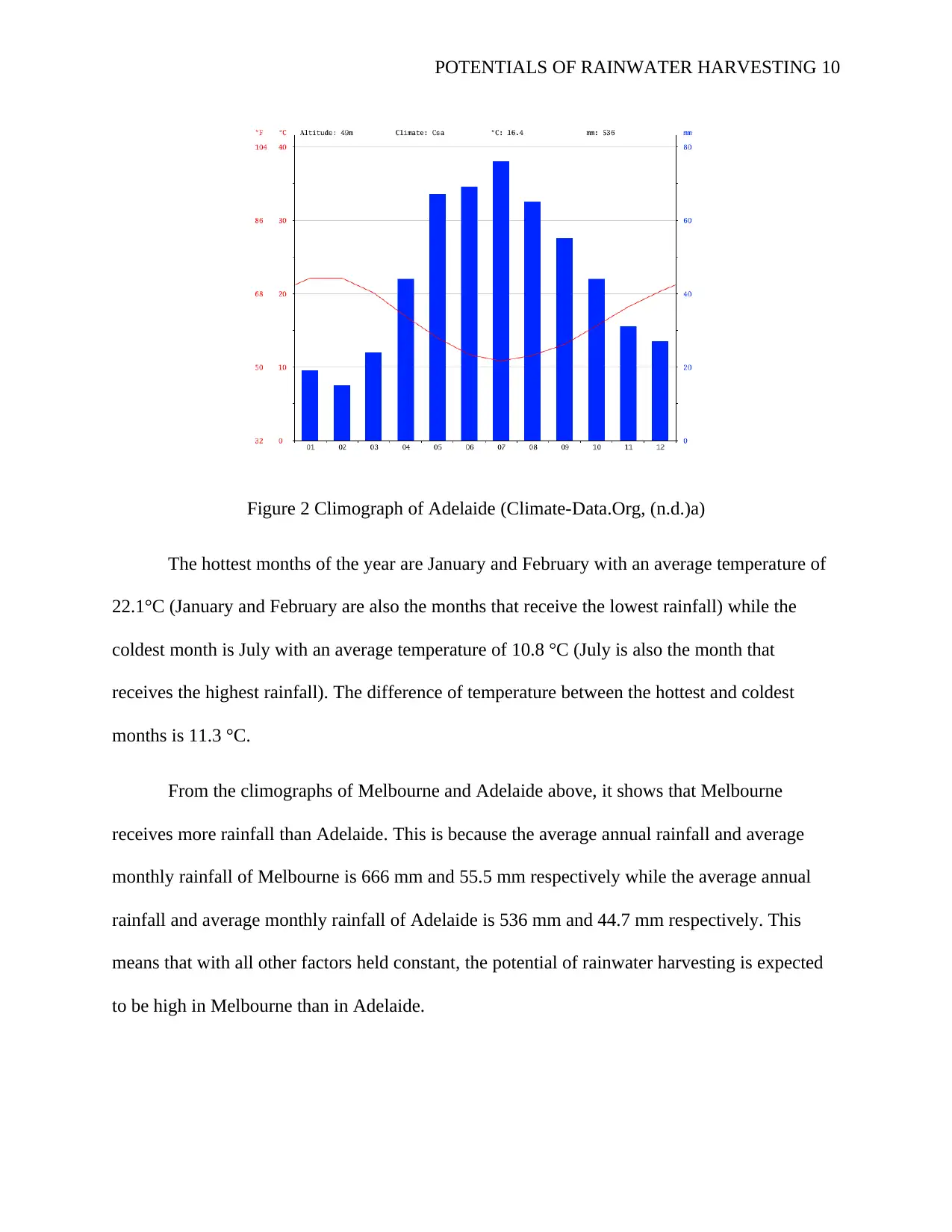
POTENTIALS OF RAINWATER HARVESTING 10
Figure 2 Climograph of Adelaide (Climate-Data.Org, (n.d.)a)
The hottest months of the year are January and February with an average temperature of
22.1°C (January and February are also the months that receive the lowest rainfall) while the
coldest month is July with an average temperature of 10.8 °C (July is also the month that
receives the highest rainfall). The difference of temperature between the hottest and coldest
months is 11.3 °C.
From the climographs of Melbourne and Adelaide above, it shows that Melbourne
receives more rainfall than Adelaide. This is because the average annual rainfall and average
monthly rainfall of Melbourne is 666 mm and 55.5 mm respectively while the average annual
rainfall and average monthly rainfall of Adelaide is 536 mm and 44.7 mm respectively. This
means that with all other factors held constant, the potential of rainwater harvesting is expected
to be high in Melbourne than in Adelaide.
Figure 2 Climograph of Adelaide (Climate-Data.Org, (n.d.)a)
The hottest months of the year are January and February with an average temperature of
22.1°C (January and February are also the months that receive the lowest rainfall) while the
coldest month is July with an average temperature of 10.8 °C (July is also the month that
receives the highest rainfall). The difference of temperature between the hottest and coldest
months is 11.3 °C.
From the climographs of Melbourne and Adelaide above, it shows that Melbourne
receives more rainfall than Adelaide. This is because the average annual rainfall and average
monthly rainfall of Melbourne is 666 mm and 55.5 mm respectively while the average annual
rainfall and average monthly rainfall of Adelaide is 536 mm and 44.7 mm respectively. This
means that with all other factors held constant, the potential of rainwater harvesting is expected
to be high in Melbourne than in Adelaide.
Paraphrase This Document
Need a fresh take? Get an instant paraphrase of this document with our AI Paraphraser
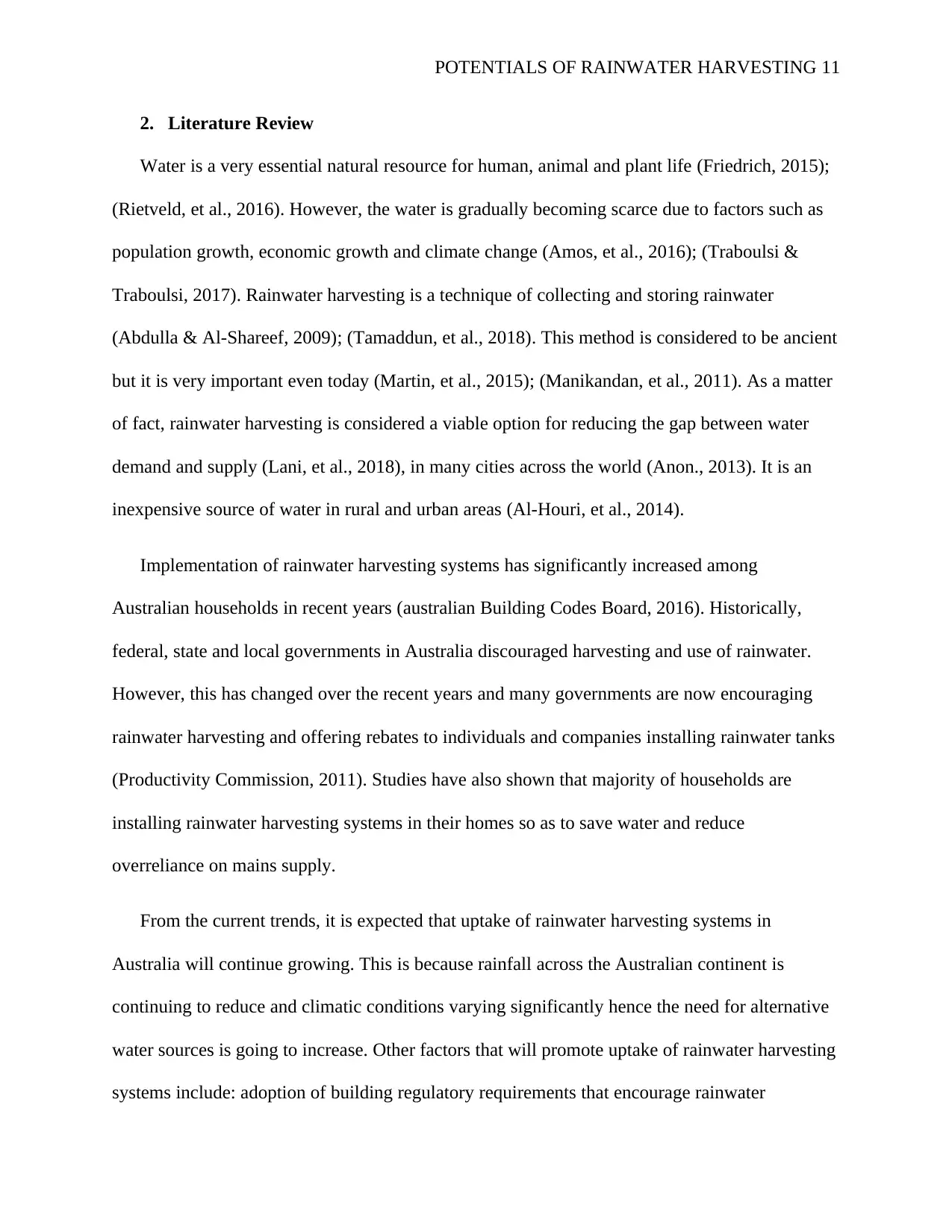
POTENTIALS OF RAINWATER HARVESTING 11
2. Literature Review
Water is a very essential natural resource for human, animal and plant life (Friedrich, 2015);
(Rietveld, et al., 2016). However, the water is gradually becoming scarce due to factors such as
population growth, economic growth and climate change (Amos, et al., 2016); (Traboulsi &
Traboulsi, 2017). Rainwater harvesting is a technique of collecting and storing rainwater
(Abdulla & Al-Shareef, 2009); (Tamaddun, et al., 2018). This method is considered to be ancient
but it is very important even today (Martin, et al., 2015); (Manikandan, et al., 2011). As a matter
of fact, rainwater harvesting is considered a viable option for reducing the gap between water
demand and supply (Lani, et al., 2018), in many cities across the world (Anon., 2013). It is an
inexpensive source of water in rural and urban areas (Al-Houri, et al., 2014).
Implementation of rainwater harvesting systems has significantly increased among
Australian households in recent years (australian Building Codes Board, 2016). Historically,
federal, state and local governments in Australia discouraged harvesting and use of rainwater.
However, this has changed over the recent years and many governments are now encouraging
rainwater harvesting and offering rebates to individuals and companies installing rainwater tanks
(Productivity Commission, 2011). Studies have also shown that majority of households are
installing rainwater harvesting systems in their homes so as to save water and reduce
overreliance on mains supply.
From the current trends, it is expected that uptake of rainwater harvesting systems in
Australia will continue growing. This is because rainfall across the Australian continent is
continuing to reduce and climatic conditions varying significantly hence the need for alternative
water sources is going to increase. Other factors that will promote uptake of rainwater harvesting
systems include: adoption of building regulatory requirements that encourage rainwater
2. Literature Review
Water is a very essential natural resource for human, animal and plant life (Friedrich, 2015);
(Rietveld, et al., 2016). However, the water is gradually becoming scarce due to factors such as
population growth, economic growth and climate change (Amos, et al., 2016); (Traboulsi &
Traboulsi, 2017). Rainwater harvesting is a technique of collecting and storing rainwater
(Abdulla & Al-Shareef, 2009); (Tamaddun, et al., 2018). This method is considered to be ancient
but it is very important even today (Martin, et al., 2015); (Manikandan, et al., 2011). As a matter
of fact, rainwater harvesting is considered a viable option for reducing the gap between water
demand and supply (Lani, et al., 2018), in many cities across the world (Anon., 2013). It is an
inexpensive source of water in rural and urban areas (Al-Houri, et al., 2014).
Implementation of rainwater harvesting systems has significantly increased among
Australian households in recent years (australian Building Codes Board, 2016). Historically,
federal, state and local governments in Australia discouraged harvesting and use of rainwater.
However, this has changed over the recent years and many governments are now encouraging
rainwater harvesting and offering rebates to individuals and companies installing rainwater tanks
(Productivity Commission, 2011). Studies have also shown that majority of households are
installing rainwater harvesting systems in their homes so as to save water and reduce
overreliance on mains supply.
From the current trends, it is expected that uptake of rainwater harvesting systems in
Australia will continue growing. This is because rainfall across the Australian continent is
continuing to reduce and climatic conditions varying significantly hence the need for alternative
water sources is going to increase. Other factors that will promote uptake of rainwater harvesting
systems include: adoption of building regulatory requirements that encourage rainwater
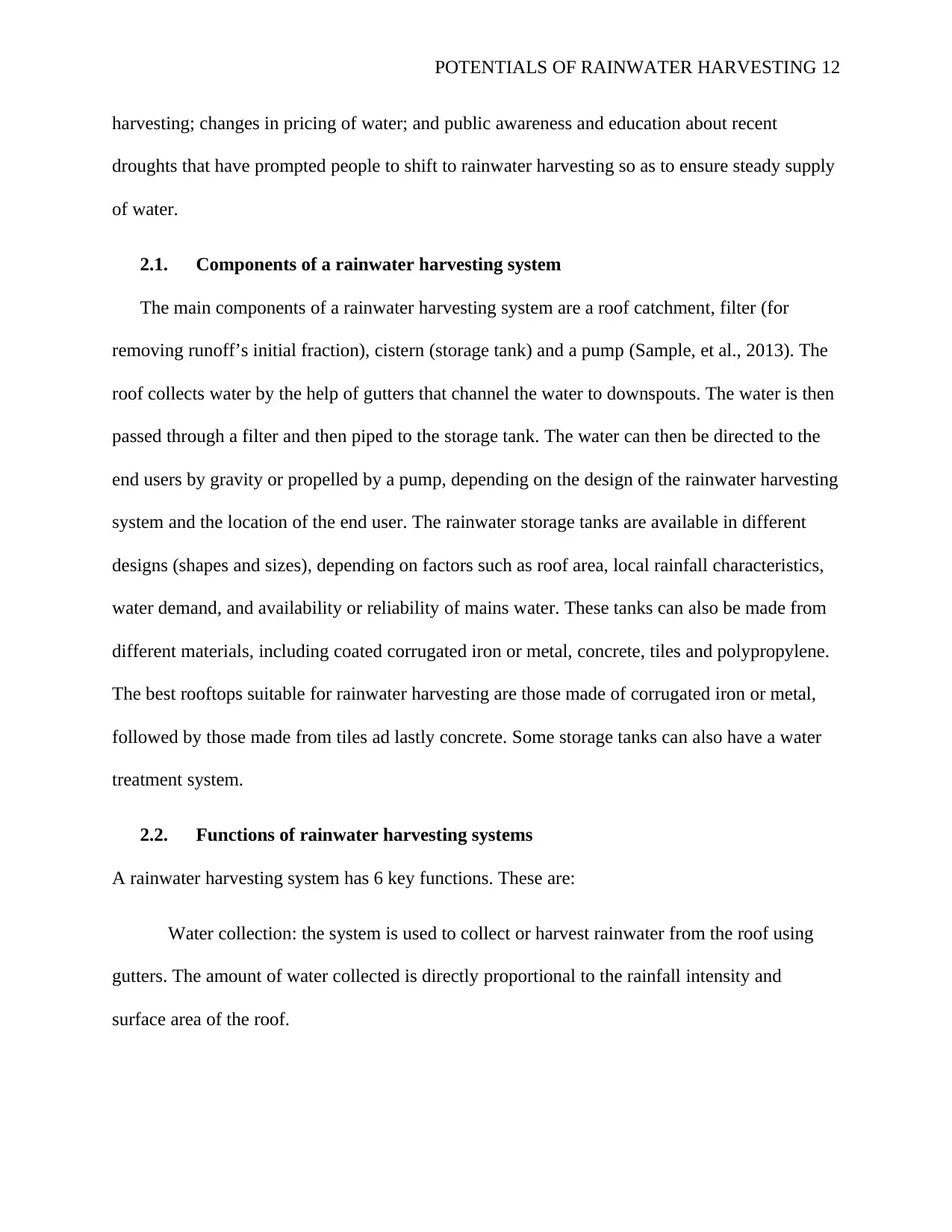
POTENTIALS OF RAINWATER HARVESTING 12
harvesting; changes in pricing of water; and public awareness and education about recent
droughts that have prompted people to shift to rainwater harvesting so as to ensure steady supply
of water.
2.1. Components of a rainwater harvesting system
The main components of a rainwater harvesting system are a roof catchment, filter (for
removing runoff’s initial fraction), cistern (storage tank) and a pump (Sample, et al., 2013). The
roof collects water by the help of gutters that channel the water to downspouts. The water is then
passed through a filter and then piped to the storage tank. The water can then be directed to the
end users by gravity or propelled by a pump, depending on the design of the rainwater harvesting
system and the location of the end user. The rainwater storage tanks are available in different
designs (shapes and sizes), depending on factors such as roof area, local rainfall characteristics,
water demand, and availability or reliability of mains water. These tanks can also be made from
different materials, including coated corrugated iron or metal, concrete, tiles and polypropylene.
The best rooftops suitable for rainwater harvesting are those made of corrugated iron or metal,
followed by those made from tiles ad lastly concrete. Some storage tanks can also have a water
treatment system.
2.2. Functions of rainwater harvesting systems
A rainwater harvesting system has 6 key functions. These are:
Water collection: the system is used to collect or harvest rainwater from the roof using
gutters. The amount of water collected is directly proportional to the rainfall intensity and
surface area of the roof.
harvesting; changes in pricing of water; and public awareness and education about recent
droughts that have prompted people to shift to rainwater harvesting so as to ensure steady supply
of water.
2.1. Components of a rainwater harvesting system
The main components of a rainwater harvesting system are a roof catchment, filter (for
removing runoff’s initial fraction), cistern (storage tank) and a pump (Sample, et al., 2013). The
roof collects water by the help of gutters that channel the water to downspouts. The water is then
passed through a filter and then piped to the storage tank. The water can then be directed to the
end users by gravity or propelled by a pump, depending on the design of the rainwater harvesting
system and the location of the end user. The rainwater storage tanks are available in different
designs (shapes and sizes), depending on factors such as roof area, local rainfall characteristics,
water demand, and availability or reliability of mains water. These tanks can also be made from
different materials, including coated corrugated iron or metal, concrete, tiles and polypropylene.
The best rooftops suitable for rainwater harvesting are those made of corrugated iron or metal,
followed by those made from tiles ad lastly concrete. Some storage tanks can also have a water
treatment system.
2.2. Functions of rainwater harvesting systems
A rainwater harvesting system has 6 key functions. These are:
Water collection: the system is used to collect or harvest rainwater from the roof using
gutters. The amount of water collected is directly proportional to the rainfall intensity and
surface area of the roof.
⊘ This is a preview!⊘
Do you want full access?
Subscribe today to unlock all pages.

Trusted by 1+ million students worldwide
1 out of 41
Related Documents
Your All-in-One AI-Powered Toolkit for Academic Success.
+13062052269
info@desklib.com
Available 24*7 on WhatsApp / Email
![[object Object]](/_next/static/media/star-bottom.7253800d.svg)
Unlock your academic potential
Copyright © 2020–2025 A2Z Services. All Rights Reserved. Developed and managed by ZUCOL.




